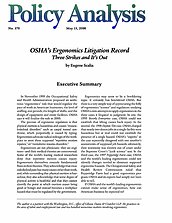In November 1999 the Occupational Safety and Health Administration proposed an ambitious “ergonomics” rule that would regulate the pace of work in American businesses, the level of staffing, rest periods, the length of shifts, and the design of equipment and entire facilities. OSHA says it will finalize the rule in 2000.
The premise of ergonomic regulation is that physical exertion is hazardous and causes “musculoskeletal disorders” such as carpal tunnel syndrome, which purportedly is caused by typing. Ergonomists advocate radical redesign of the workplace to avert these supposed “repetitive motion injuries,” or “cumulative trauma disorders.”
Ergonomists are not physicians–they are engineers–and their medical theories are controversial. Some of the world’s leading medical researchers deny that repetitive motion causes injury. Ergonomists themselves concede fundamental flaws in their theories. They acknowledge that musculoskeletal pain has many causes other than work, and, while contending that physical exertion is hazardous, they also acknowledge that some degree of physical activity is healthful and that they cannot identify the point at which exertion ceases being good or benign and instead becomes a workplace hazard that must be regulated by the government.
Ergonomics may seem to be a bewildering topic. It certainly has bewildered OSHA. But there is a very simple way of appreciating the folly of ergonomics “science” and regulation: studying OSHA’s own attempts to apply ergonomics in the three cases it litigated to judgment. In one, the 1995 Beverly Enterprises case, OSHA could not establish that lifting causes back injury. In the second, the 1998 Dayton Tire case, OSHA charged that nearly two dozen jobs in a single facility were hazardous but at trial could not establish the presence of a single hazard. OSHA’s “experts” in the case repeatedly disagreed with one another’s assessments of supposed job hazards; ultimately, their testimony was thrown out of court under the Supreme Court’s “junk science” test. In the third case, the 1997 Pepperidge Farm case, OSHA and the world’s leading ergonomists could not identify changes needed to eliminate supposed ergonomic hazards. The Occupational Safety and Health Review Commission ruled that Pepperidge Farm had a good ergonomics program; OSHA and its experts had simply not been able to tell.
If OSHA and the world’s leading ergonomists cannot make sense of ergonomics, how can American business be expected to?
About the Author

This work is licensed under a Creative Commons Attribution-NonCommercial-ShareAlike 4.0 International License.
